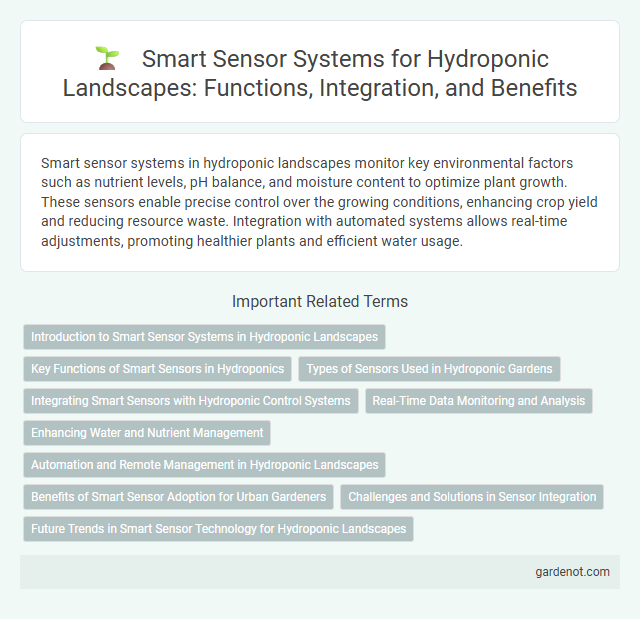Smart sensor systems in hydroponic landscapes monitor key environmental factors such as nutrient levels, pH balance, and moisture content to optimize plant growth. These sensors enable precise control over the growing conditions, enhancing crop yield and reducing resource waste. Integration with automated systems allows real-time adjustments, promoting healthier plants and efficient water usage.
Introduction to Smart Sensor Systems in Hydroponic Landscapes
Smart sensor systems in hydroponic landscapes utilize advanced IoT technology to monitor crucial parameters such as nutrient levels, pH balance, humidity, and temperature, enabling precise control over plant growth environments. These integrated sensors collect real-time data, enhancing resource efficiency by optimizing water and nutrient usage while minimizing waste. Implementing smart sensor systems improves crop yield quality and sustainability in hydroponic farming by ensuring optimal conditions are consistently maintained.
Key Functions of Smart Sensors in Hydroponics
Smart sensor systems in hydroponics optimize plant growth by continuously monitoring nutrient levels, pH balance, and water temperature to maintain ideal conditions. These sensors provide real-time data to automated control systems, enabling precise adjustments to nutrient delivery and environmental factors. This technology enhances crop yield, reduces resource waste, and ensures consistent quality in hydroponic farming.
Types of Sensors Used in Hydroponic Gardens
Hydroponic gardens utilize a variety of smart sensors to optimize plant growth, including pH sensors for monitoring nutrient solution acidity, EC (electrical conductivity) sensors to measure nutrient concentration, and temperature sensors that ensure optimal root zone conditions. Light sensors adjust LED grow lights based on natural light availability, while humidity sensors maintain ideal air moisture levels. Oxygen sensors are also employed to track dissolved oxygen in water, crucial for root health and efficient nutrient uptake.
Integrating Smart Sensors with Hydroponic Control Systems
Integrating smart sensors with hydroponic control systems enhances precision by continuously monitoring key parameters such as pH, temperature, humidity, and nutrient concentration. These sensors provide real-time data that enable automated adjustments, optimizing plant growth conditions and resource usage. Advanced IoT-enabled sensor networks facilitate remote management and predictive maintenance, significantly improving system efficiency and crop yield in hydroponic landscapes.
Real-Time Data Monitoring and Analysis
Smart sensor systems in hydroponic landscapes enable real-time data monitoring and analysis of critical parameters such as nutrient levels, pH balance, temperature, and humidity. These advanced sensors provide continuous, precise measurements that optimize plant growth conditions, reduce resource waste, and prevent disease outbreaks. Integration with automated control systems allows for instant adjustments, enhancing crop yield and sustainability in hydroponic farming.
Enhancing Water and Nutrient Management
Smart sensor systems in hydroponic landscapes utilize real-time monitoring of pH, moisture, and nutrient concentrations to optimize water and nutrient delivery. These technologies reduce waste by precisely adjusting irrigation schedules and nutrient dosing based on plant requirements and environmental conditions. Integrating data analytics allows for predictive maintenance, ensuring consistent plant health and maximizing resource efficiency.
Automation and Remote Management in Hydroponic Landscapes
Smart sensor systems in hydroponic landscapes enable precise automation by continuously monitoring parameters such as pH, nutrient concentration, temperature, and humidity. These sensors integrate with IoT platforms to facilitate remote management, allowing growers to adjust settings and receive real-time alerts through mobile devices or cloud-based dashboards. Automation driven by smart sensors optimizes resource use, enhances plant growth, and reduces labor costs in hydroponic farming.
Benefits of Smart Sensor Adoption for Urban Gardeners
Smart sensor systems enhance hydroponic landscapes by providing real-time data on nutrient levels, pH balance, and moisture content, optimizing plant growth and health. Urban gardeners benefit from increased efficiency and reduced resource waste through precise monitoring and automation. These technologies enable remote management and predictive maintenance, promoting sustainable urban agriculture and higher yields in limited spaces.
Challenges and Solutions in Sensor Integration
Smart sensor systems in hydroponic landscapes face challenges such as sensor calibration inaccuracies, data integration delays, and environmental interference affecting sensor readings. Implementing advanced calibration algorithms, real-time data processing frameworks, and robust sensor shielding enhances data accuracy and system reliability. These solutions ensure precise monitoring of nutrient levels, pH, and moisture, optimizing plant growth conditions and resource use.
Future Trends in Smart Sensor Technology for Hydroponic Landscapes
Future trends in smart sensor technology for hydroponic landscapes emphasize enhanced precision and real-time monitoring through AI-driven analytics and IoT integration. Advanced sensors capable of detecting micro-nutrient levels, humidity, and pH fluctuations enable proactive adjustments, optimizing plant health and growth efficiency. Innovations in wireless sensor networks and energy-efficient devices promise scalable, sustainable solutions for urban and commercial hydroponic farming.
Smart sensor system Infographic

 gardenot.com
gardenot.com